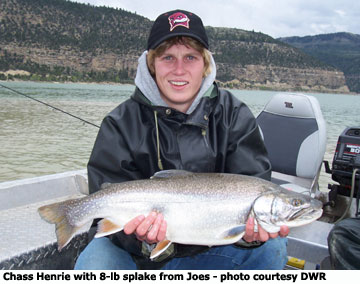
Joes Valley Offers Big Splake
 (This
DWR news release provides excellent information about spring fishing at
a lesser-know but very productive reservoir.)
(This
DWR news release provides excellent information about spring fishing at
a lesser-know but very productive reservoir.)
The best time to stand on the shore and catch a 10-pound splake at Joes Valley Reservoir is only a short time away.
From the end of April (which is when ice-off generally occurs) through the month of May, shoreline anglers have an excellent opportunity to catch a trophy-sized splake using little or no special equipment.
Anglers fishing at Joes Valley seem to have the best luck using pieces of Utah chub, a baitfish that can be caught easily at the reservoir.
What's a splake?
Splake are sterile trout that are developed by crossing a brook trout and a lake trout. Hence the name.
Sterile trout such as splake cannot reproduce. This makes it easier for fisheries managers to keep the number of trout at a level that provides them with plenty of food. Because there's plenty of food to eat, the trout grow rapidly. Splake also grow bigger faster because they're not using their energy to reproduce.
Getting to Joes Valley
Joes Valley Reservoir sits between the towns of Ephraim and Orangeville in the Manti-LaSal National Forest in central Utah.
Although the Skyline Drive provides access to Joes Valley from Ephraim, this route is unpaved and impassable for much of the year. A better route is the scenic 19-mile drive along SR-29 from the town of Orangeville. This paved road provides easy access to the reservoir, which sits at an elevation of about 7,000 feet.
Tips for catching splake
Large splake become active following ice-off and move close to shore in search of their primary prey-the Utah chub. The best places to find the big predators are at the mouths of the reservoir's tributaries, such as Seely Creek on the reservoir's west side.
Early morning is the best time to wet your line. As the sun warms the water, the big fish are driven into colder, deeper water and are harder to find.
Fisheries biologists agree that "the bigger the bait, the bigger the fish you'll catch." However, the smaller splake will not feed on larger bait. If you use an entire chub as bait may, you probably won't catch as many fish.
To catch chubs for bait, simply use a minnow trap or fish with a small hook and a piece of worm on a fishing rod and reel. Once you've caught a chub, kill it and then hook it securely to your line with a moderately-sized bait holder. Remember that fishing with live bait, including live chubs, is illegal (that's how Joes Valley got its chub problem in the first place)!
Use a sinker of your choice to put your bait on the bottom of the reservoir, or just off the bottom. Big splake can be taken in as little as two feet of water or hooked farther out from shore as they cruise the shallows looking for a bite.
Lots of four- to six-pound fish
Splake as large as 15 pounds have been documented at the reservoir, although a fish that large is extremely rare. Anglers can and do take splake up to 10 pounds and fish in the 4- to 6-pound class are abundant. And while you're hunting for that trophy splake, get ready for the chance to hook a cutthroat trout that could go up to 20 inches in length or a tiger trout that goes up to 15 inches long.
Special regulations apply to all of the trout caught at Joes Valley. The limit is two fish, but only one can be greater than 22 inches in length. All fish between 15 and 22 inches must be released immediately. These regulations are designed to build and maintain the quality of the fishing at Joes Valley and to control the reservoir's greatest nemesis-the Utah chub.
Relaxing at Joes Valley
While you're waiting for a jerk on your line, you'll be rewarded with a spacious panorama of forested mountains, craggy escarpments and a well-watered valley. The U.S. Forest Service operates a lakeside campground at Joes Valley. Visitors will also find a marina, parking areas and restrooms.
You can expect to see deer, elk and an occasional moose during your visit. And birdwatchers will enjoy a variety of birds, including eagles, hawks, osprey and peregrine falcons.
If you or someone else in your party gets tired of fishing, plenty of off-highway vehicle and hiking trails are available in the surrounding mountains.
Except for holidays, the fishing pressure at Joes Valley Reservoir is usually light. You can expect a relaxed, easy-going experience. Fishing tackle, groceries and fuel can be purchased in Orangeville on your way to the reservoir.
If you haven't experienced Joes Valley Reservoir before, plan a trip this spring. You should return home with a nice fish and some wonderful memories!
Copyright DWR, 2006